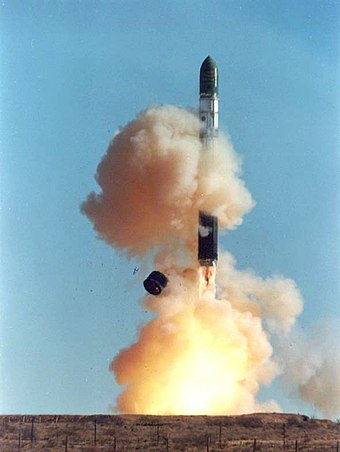
Back R-36 (raket) Azerbaijani Р-36 Bulgarian R-36 (raketa) Czech R-36 German R-36 Spanish R-36 Finnish R-36 French R-36 HE आर-36 Hindi R-36 Croatian
This article needs additional citations for verification. (September 2022) |
| R-36 | |
|---|---|
 Liftoff of a Dnepr rocket, a launch vehicle derived from the R-36 ICBM | |
| Type | Intercontinental ballistic missile |
| Place of origin | Soviet Union |
| Service history | |
| In service | 1966–1979 (original variant) 1988–present (R-36M2 Voevoda variant) |
| Used by | Russian Strategic Rocket Forces |
| Production history | |
| Designed | From 1962 |
| Manufacturer | Factory: Yuzhny Machine-Building Plant Developer: Yuzhnoye Design Office |
| Unit cost | $7,000,000 |
| Specifications | |
| Mass | 209,600 kg (462,100 lb) |
| Length |
|
| Diameter | 3,050 mm (120 in) |
| Warhead | Depending on variant (see variants). Newest (R-36M2), 10 × 550–750 kiloton MIRV warheads with a large amount of decoys and other penetration aids. Originally (R-36), 1 × 8–20 megaton warhead. |
| Engine | Two or often three liquid fueled rocket stages First Stage: Second Stage: Third Stage: |
| Propellant | N2O4/UDMH |
Operational range | 10,200–16,000 km |
Guidance system | Inertial, autonomous |
| Accuracy | 220–1,300 m CEP |
Launch platform | Silo |
The R-36 (Russian: Р-36) is a family of intercontinental ballistic missiles (ICBMs) and space launch vehicles (Tsyklon) designed by the Soviet Union during the Cold War. The original R-36 was deployed under the GRAU index 8K67 and was given the NATO reporting name SS-9 Scarp. It was able to carry three warheads and was the first Soviet MRV (multiple re-entry vehicle) missile.[4] The later version, the R-36M, also known as RS20, was produced under the GRAU designations 15A14 and 15A18 and was given the NATO reporting name SS-18 Satan. This missile was viewed by certain United States analysts as giving the Soviet Union first strike advantage over the U.S., particularly because of its rapid silo-reload ability, very heavy throw weight and extremely large number of re-entry vehicles. Some versions of the R-36M were deployed with 10 warheads and up to 40 penetration aids and the missile's high throw-weight made it theoretically capable of carrying more warheads or penetration aids. Contemporary U.S. missiles, such as the Minuteman III, carried up to three warheads at most.
The R-36 became the base for the Tsyklon launch vehicles family. As of early 2021, Cyclone-4M, the last Tsyklon variant in development, is planned for launch in 2023 from Canso, Nova Scotia.[5]
Some R-36 missiles have been converted into Dnepr medium-lift launch vehicles, capable of putting up to 4,500 kg into orbit.
- ^ a b Krebs, Gunter D. "R-36 (SS-9, Scarp) ICBM". Retrieved 25 July 2022.
- ^ "NPO Energomash list of engines". NPO Energomash. Archived from the original on 7 November 2014.
- ^ a b c Krebs, Gunter D. "R-36M Voivode (SS-18, Satan) ICBM". Retrieved 25 July 2022.
- ^ Helms, Richard; Hood, William (2004). A Look Over My Shoulder: A Life in the Central Intelligence Agency. Random House Publishing. p. 385. ISBN 0-8129-7108-6.
- ^ Willick, Frances (12 May 2021). "Canso spaceport secures $10.5M, aims for first launch next year". CBC News. Retrieved 14 May 2021.
© MMXXIII Rich X Search. We shall prevail. All rights reserved. Rich X Search